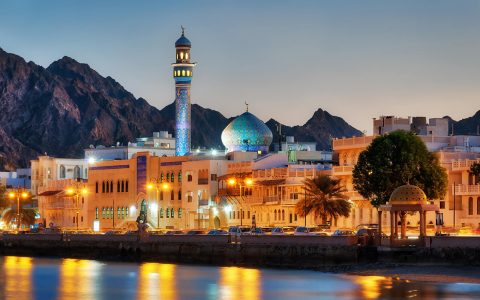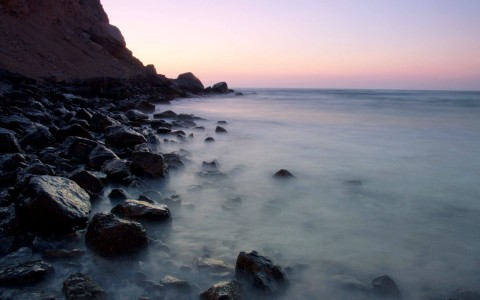Insider’s Guide: Things to See and Do in Muscat
 A hidden gem on the Arabian gulf, the serenity and tranquility of Oman is unparalleled. An intriguing mix of traditional and modern, here are some of the key attractions you’ll find in and around the capital city of Muscat.
A hidden gem on the Arabian gulf, the serenity and tranquility of Oman is unparalleled. An intriguing mix of traditional and modern, here are some of the key attractions you’ll find in and around the capital city of Muscat.
The Grand Mosque
A prime example of modern Islamic architecture, able to hold 20,000 worshipers, was built by Sultan Qaboos ibn Sa’id to commemorate his 30th year of reign.
Built from precious materials from around the world including marble, sandstone, and Swarovski crystal on the chandelier. Here, you’ll find the second-largest Persian carpet in the world; it took 600 women four years to weave it to completion. It’s best to head here early in the morning (before 9:30 a.m.) to avoid massive crowds. It’s important to know that the mosque closes to the public at 11 a.m. every day, and is closed all day on Fridays for worship.
 Next to the mosque, there is an information centre where you are offered dates and coffee, and an opportunity to sit down with religious leaders who share information about Islam and answer any questions you may have. They are trained to handle even the more complicated questions about their faith; some of these teachers have even lived in North America for many years, so ask away!
Next to the mosque, there is an information centre where you are offered dates and coffee, and an opportunity to sit down with religious leaders who share information about Islam and answer any questions you may have. They are trained to handle even the more complicated questions about their faith; some of these teachers have even lived in North America for many years, so ask away!
 Omani religion, unique in the Muslim world, is one of the special things about this country. First adopted by the cities surrounding Nizwa, Ibadism is the ‘third way’ of Islam. Going back to the 8th century, the Muslim world split in two, forming the Shiite and Sunni branches of the religion. Ibadism, which actually predates both Shiite and Sunni, is more tolerant and open, as anyone can be elected Imam (as opposed to inheriting the title).
Omani religion, unique in the Muslim world, is one of the special things about this country. First adopted by the cities surrounding Nizwa, Ibadism is the ‘third way’ of Islam. Going back to the 8th century, the Muslim world split in two, forming the Shiite and Sunni branches of the religion. Ibadism, which actually predates both Shiite and Sunni, is more tolerant and open, as anyone can be elected Imam (as opposed to inheriting the title).
Ibadism is one of the reasons social peace is kept in Oman. The country often acts as mediator between the Shiite majority in Iran, which falls on the eastern border and the Sunnis of Saudi Arabia to the north.

 Sultan’s Palace
Sultan’s Palace
The most photographed place in Oman, the palace is not open to the general public, but you can have an evening stroll along the corniche and have a look at it when it is lit up at night. The palace is used by the sultan for receptions and parties only. His actual palace is actually 20 miles north out of Muscat and not a place that’s accessible to ordinary people.
Royal Opera House
The best in the Middle East and boasting some of the world’s best acoustics, showtimes are usually on Fridays and Saturdays. The programming is excellent, and tickets are on the cheap side; for instance, you might be able to see world-renowned tenor Placido Domingo for just $100 USD! It’s nice to combine a night at the opera with dinner at Al Angham for delicious Middle Eastern cuisine, or Fauchon for international flair.
See For Yourself
On our Oman Walking trip, see what makes Oman so special: its mystical culture and ancient souks, the soaring Hajar Mountains, endless white-sand beaches, the imposing Wahiba Sands—and of course the Omani Grand Canyon.
DETAILED ITINERARY
Mutrah fish market for local flavour

To get a taste of what local life is like, head to the fish market, as early as sunrise, when the fishermen return with their freshest catch of the day. Be sure to get there before 10 a.m., as all the action will be over by then. This wet market is brimming with locals bargaining, and the ocean’s bounty is on full display, from shark to tuna, moray eel, skate and even wild shrimp.
The fish market in Muscat (Mutrah) is best seen in the early morning, before 10 a.m. (by this time, they’ll be shutting down). In fact, the fish market begins about sunrise, as fishermen return with their fresh catches of the day. Oman has a long tradition of living off the sea.
When the Sultan boosted Oman’s economy with oil money, he kept traditions alive, subsidizing the smaller ‘floating cigar’ boats and dhow boats that remain in use, shunning the use of larger boats and modern trawlers. A common seafood item eaten by Omanis is dried shark meat soup, but with shark being sought after (especially in Asia), the authorities have forbidden any shark meat exports, thus safeguarding this traditional dish.

 Mutrah corniche for an evening stroll, followed by the souk
Mutrah corniche for an evening stroll, followed by the souk
Striking a gorgeous silhouette as the sun sets, the magic hour is the perfect time to walk around and stroll after dinner. If you’re walking from the Sultan’s palace, it will take you about 45 minutes to arrive to the corniche for a bit of liveliness and a refreshing breeze from the ocean.
Make your way to the souk (marketplace) in the evening, the best time to see the vendors’ wares glittering and shining in the light; I find it a bit empty in the daytime. If you are looking for souvenirs, this is the best place to purchase the coveted frankincense of Oman, as well as pashmina scarves. You can find a few antique shops at the souk, but I recommend going to Nizwa if that’s what you are after.

Sip some Omani coffee
 In Oman, the stimulating effects of caffeine were first observed by goat herders, who noticed their animals’ sleeping habits extended long after eating fruits from a certain bush.
In Oman, the stimulating effects of caffeine were first observed by goat herders, who noticed their animals’ sleeping habits extended long after eating fruits from a certain bush.
The coffee beans were collected and used in stews, with the bitterness counterbalanced with the addition of honey. Eventually, the modern coffee-drinking practice of roasting, crushing and brewing beans was adopted, along with a side order of dates for sweetness, as sugar wasn’t readily available at the time.
 A day trip to Wadi Shab and Sur
A day trip to Wadi Shab and Sur
Experience the miracle of water in the desert at a wadi. Worth the two-hour drive south of Muscat, Wadi Shab is an ideal day trip, but avoid Fridays and Saturdays, as this is when the crowds peak. Be sure to check the weather forecast before planning a trip to Wadi Shab, as when there is rain in the mountains, the canyon will be closed to all visitors.
This canyon, which narrows as you walk deeper into the wadi, is accessed by boat at first. Cross the river, walk on the well-marked trail, and make your way to the end, where you’ll find caves to swim in, natural waterfalls and a desert oasis haven.
I recommend a stop at the Wadi Shah hotel for lunch and a swim at the beach, or combining your visit to the seaside town of Sur.
 Just a quick 20-minute drive south of Wadi Shab, Sur was once a slave trading harbour, and as a result its population differs from the rest of Oman. Here, you’ll see the famous dhow boat factories it’s known for, as well as its market; all in all, a wonderful day trip to get out of Muscat.
Just a quick 20-minute drive south of Wadi Shab, Sur was once a slave trading harbour, and as a result its population differs from the rest of Oman. Here, you’ll see the famous dhow boat factories it’s known for, as well as its market; all in all, a wonderful day trip to get out of Muscat.
MORE FROM Africa and Middle East + Oman

6 Amazing Things To See and Do in Oman
Oman
In Oman, A Secret Worth Keeping
Oman
